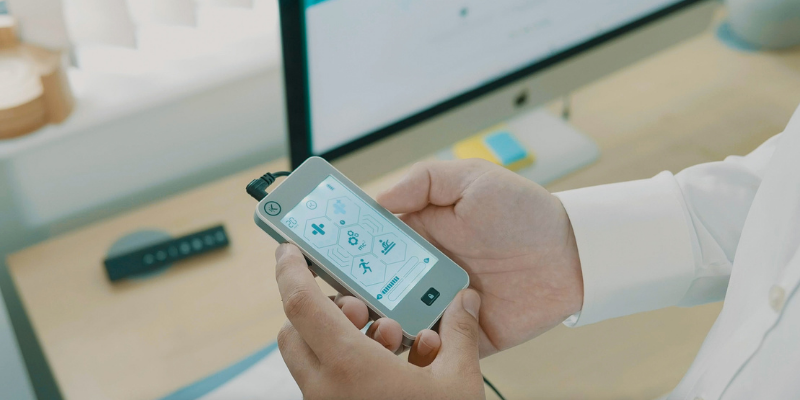
Working from home continues to be the norm, and research suggests 26% of Brits plan to keep their ‘home-office’ post-lockdown. While there are many perks to working from home, NuroKor’s resident physiotherapist Hilde Hjertholm advises:
“It is important to maintain physical and mental health in the shift to working from home, there are practical steps which can be taken to make home working more comfortable and satisfying, whether you have been doing it for a long time, or whether its brand new for you.”
HILDE SHARES HER TOP 'WORKING FROM HOME' TIPS
1. Pain proof the home-office
"If you are setting up your computer or desk at home, it can be hard to achieve the same set-up as your normal office. You need to try as hard as possible to ensure your working area follows good ergonomic principles in order to prevent back and neck pain.
"This can be hard in make-shift office spaces. However, try to utilise the support of your chair and desk and keep the screen at arm's length with eyes gazing towards the top of the screen."

2. Create a new home routine
"Trying to preserve some sense of normality is really important for your well-being, and good mental health promotes good physical health. You should try and maintain some kind of routine, ensuring you get up at a ‘normal’ time, get dressed and have a plan for your day. It might help to maintain a similar pattern to your usual routine."

3. Take regular breaks and keep moving
"Taking regular ‘moving’ breaks can really help both physically and mentally. Getting up from your desk not only helps to ease tension in the body, particularly neck, back and shoulders, but it has the added benefit of maintaining focus.
"Often sitting at a desk for many hours can trigger back pain. If you have a sore back, your first instinct can often be to retreat to your bed, lie down and minimise all movement.

"But in fact, movement is a great strategy to combat and prevent mild to moderate back pain. On top of this, basic aerobic exercise such as walking and cycling increases the blood flow and nutrients to the soft tissue in the back, helping reduce the stiffness that often results in back pain."
4. Build stretching into your day
"As well as general moving, it is worth building some stretching into your working day. Stretching is essential to maintain flexibility and avoid muscle stiffness.
"If you can, spend five minutes or so in the morning doing a few light all-over body stretches."

Then stretch now and then throughout the day to relieve tension or if you've been sitting or standing in one position for long periods.
Spending a lot of time on computers and phones makes us prone to poor posture. So, to open up your chest and stretch your chest muscles is very important. Doorway stretches are simple, but effective ways to stretch your chest. Place both hands on the door frame and pull your body in line with the door to stretch your chest muscle. Hold for 15-20 seconds and repeat 3-4 times.

5. Turn your home into a gym
"Just because you are working from home, it doesn’t mean you need to reduce your fitness goals.. you can actually get a great workout just by doing exercises using your own bodyweight, for example - push ups, squats, jumping jacks, wall sits and crunches. There are ways to add resistance even when lacking proper gym equipment. Be creative and use stuff you have in your home.

"If you have access to stairs in your home, going up and down those stairs is a great way to get your blood pumping, or even just do highs-knees or turn on the music and dance like nobody`s watching.
"Alternatively, you can go outside for a run, walk or cycle. Or if it is rainy and cold and you don’t fancy leaving the house, there are a whole host of training apps or online videos that offer work outs for all levels and can be done indoors."

6. Eat and drink well
"Working from home can often lead to bad eating habits, and you can often forget to drink enough water throughout the day. To help you instil good eating habits when working from home, try to stick to eating at meal times, and if you feel like you need a snack, try and go for healthy options such as fruit, nuts or something like carrot or celery sticks. Try to avoid high-fat or sugary foods and snacks. After an initial buzz, they can often leave you feeling lethargic.
"To help you drink regularly, having a water bottle on your desk will remind you to keep hydrated."

7. Use bioelectrical therapy at home
NuroKor bioelectrical therapy is effective for relieving most types of pains in a natural way and is perfect for use at home.
If you feel like your back, neck or any other muscles are sore or stiff from too many hours at your home desk, you can use NuroKor to relieve sore and stiff muscles, as well as using it to stimulate blood circulation.

"The NuroKor devices are very easy to use any time of day, even in front of the TV, reading a book or indeed whilst you are working at your computer."

If you are actually doing more training as you have more time without a commute, NuroKor can also be used both for activating and maintaining your muscles, as well as to intensify your workout by using it while you do your specific strengthening training.
To keep up to date with NuroKor athlete news and other stories follow @NuroKor on FB, Instagram & Twitter.



